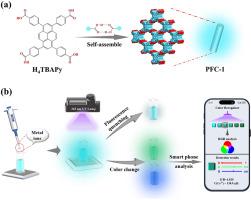A pyrene-based hydrogen-bonded framework with excimer induced ratiometric emission for discriminative luminescence detection of metal ions
IF 4.8
3区 材料科学
Q1 CHEMISTRY, APPLIED
引用次数: 0
Abstract
Discriminatory fluorescence detection of various metal ions is of significant importance in environmental and health-related applications. A luminescent hydrogen-bonded organic framework (HOF) material, PFC-1 was synthesized using 1,3,6,8-tetra(4-carboxylbenzene) pyrene (H4TBAPy) as the organic building block. The fluorescence behavior of PFC-1 is influenced by the concentration of the suspension, demonstrating different emissions characteristic of monomer and excimer fluorescence, which are highly sensitive to the surrounding environment. This allows for the potential differentiation and sensing of different target analytes. PFC-1 showed discriminatory fluorescence sensing performance towards metal ions such as Al3+, Sc3+, Cr3+, and Cu2+, with changes in fluorescence intensity, emission peak shifts, and intensity ratio changes between monomer and excimer emissions. Furthermore, a smartphone-based detection strategy was proposed, leveraging color recognition capabilities of smartphones for onsite and real-time sensing. The work demonstrate that PFC-1 is a promising material for the development of portable, cost-effective fluorescent sensors for onsite and real-time detection of metal ions. The integration of PFC-1 with smartphone technology paves the way for practical applications in environmental monitoring, industrial processes, and healthcare diagnostics.

具有准分子诱导比率发射的芘基氢键框架,用于金属离子的鉴别性发光检测
各种金属离子的荧光鉴别检测在环境和健康相关应用中具有重要意义。以 1,3,6,8-四(4-羧基苯)芘(H4TBAPy)为有机结构单元,合成了发光氢键有机框架(HOF)材料 PFC-1。PFC-1 的荧光行为受悬浮液浓度的影响,表现出单体荧光和准分子荧光的不同发射特征,对周围环境高度敏感。这就为区分和感测不同的目标分析物提供了可能。PFC-1 对 Al3+、Sc3+、Cr3+ 和 Cu2+ 等金属离子表现出分辨荧光传感性能,其荧光强度、发射峰移动以及单体和准分子发射之间的强度比都发生了变化。此外,还提出了一种基于智能手机的检测策略,利用智能手机的颜色识别能力进行现场和实时检测。研究结果表明,PFC-1 是一种很有前途的材料,可用于开发现场和实时检测金属离子的便携式、经济高效的荧光传感器。PFC-1 与智能手机技术的整合为环境监测、工业过程和医疗诊断的实际应用铺平了道路。
本文章由计算机程序翻译,如有差异,请以英文原文为准。
求助全文
约1分钟内获得全文
求助全文
来源期刊

Microporous and Mesoporous Materials
化学-材料科学:综合
CiteScore
10.70
自引率
5.80%
发文量
649
审稿时长
26 days
期刊介绍:
Microporous and Mesoporous Materials covers novel and significant aspects of porous solids classified as either microporous (pore size up to 2 nm) or mesoporous (pore size 2 to 50 nm). The porosity should have a specific impact on the material properties or application. Typical examples are zeolites and zeolite-like materials, pillared materials, clathrasils and clathrates, carbon molecular sieves, ordered mesoporous materials, organic/inorganic porous hybrid materials, or porous metal oxides. Both natural and synthetic porous materials are within the scope of the journal.
Topics which are particularly of interest include:
All aspects of natural microporous and mesoporous solids
The synthesis of crystalline or amorphous porous materials
The physico-chemical characterization of microporous and mesoporous solids, especially spectroscopic and microscopic
The modification of microporous and mesoporous solids, for example by ion exchange or solid-state reactions
All topics related to diffusion of mobile species in the pores of microporous and mesoporous materials
Adsorption (and other separation techniques) using microporous or mesoporous adsorbents
Catalysis by microporous and mesoporous materials
Host/guest interactions
Theoretical chemistry and modelling of host/guest interactions
All topics related to the application of microporous and mesoporous materials in industrial catalysis, separation technology, environmental protection, electrochemistry, membranes, sensors, optical devices, etc.
 求助内容:
求助内容: 应助结果提醒方式:
应助结果提醒方式:


